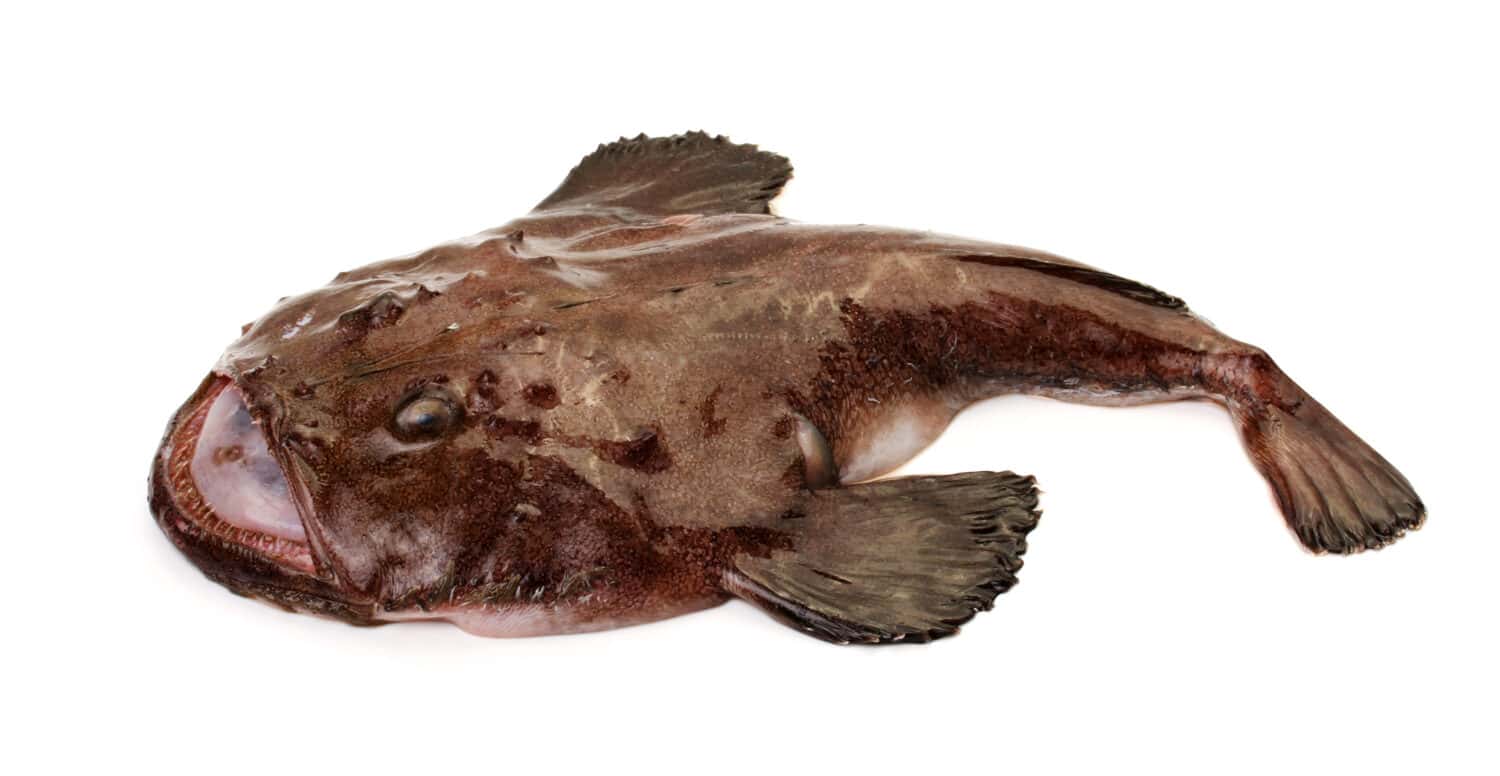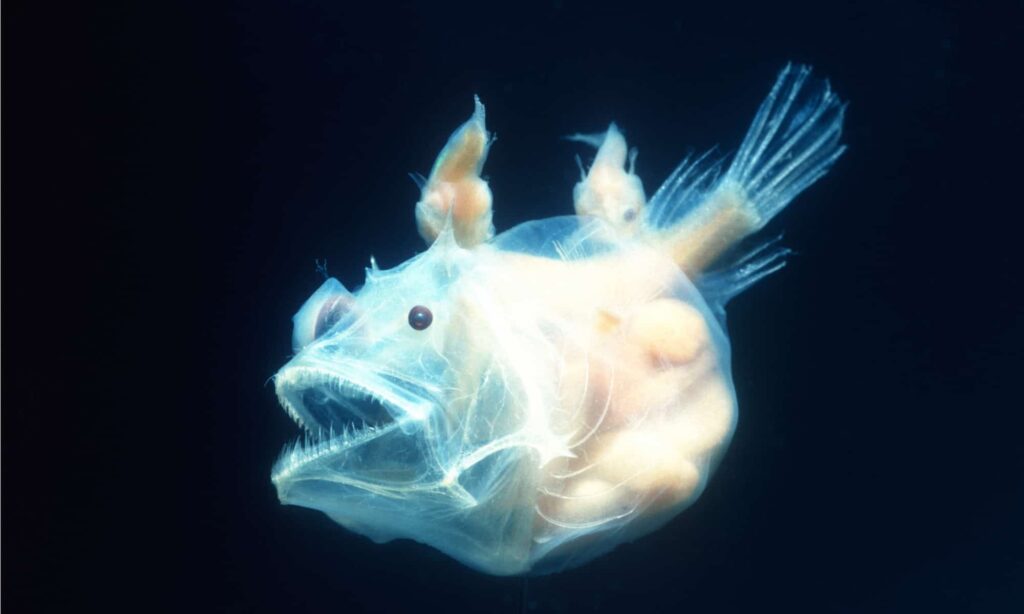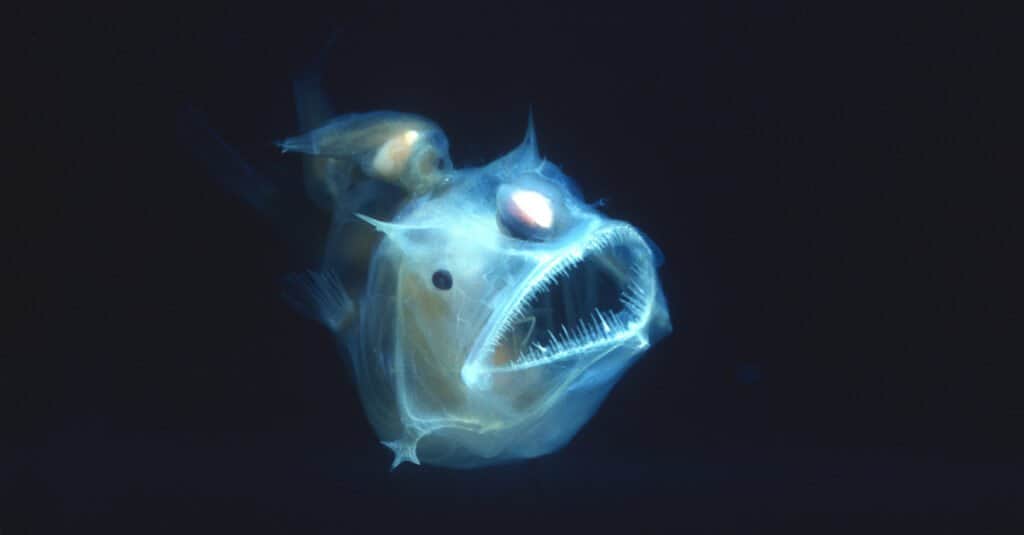Some humans have complicated love lives, and there is rivalry in many animal affairs as well, but few come as close to strange as the relationship held between some species of male and female anglerfish. This bizarre relationship is one that has enchanted and grossed us out since we started learning about these deep-sea critters in 1833. Most of what we know about anglerfish is based on dead or dying specimens that wash up on different shores around the world.
There are over 200 species of anglerfish in the world’s oceans, and it so follows that we can’t expect them to all share the same breeding rituals. Today, we’ll be taking a look at one of the most distinct breeding rituals out of all of these species — the mating habits of the most recognizable deep-sea anglerfish, the humpback anglerfish (Melanocetus johnsoni). Their species name translates to “large black sea creature.” Let’s take a closer look at the relationship shared between the male and female of this species.
What Is an Anglerfish?

This big monkfish is one variety of anglerfish, but it does not have the same habits or breeding styles as some of its more distant family members.
©zcw/Shutterstock.com
Anglerfish all come from the Teleost order Lophiiformes. Teleosts are mostly differentiated from other fish by their jaws. The maxilla and premaxilla – the two parts of the upper jaw that form the biting surface — are movable in teleosts. This means that these fish have the ability to protrude their jaws when opening their mouths. Another defining characteristic of teleosts is a symmetrical tail. Teleost fish come in all shapes and sizes. They also occupy every portion of the ocean, from the shelves of shallow-water reefs to the deepest and darkest parts of the oceanic abyss.
Lophiiformes are represented by 322 species of fish, most of them being benthic (bottom-dwelling) shallow-water fish. Anglerfish are the most common example of Lophiiformes, but several other species occupy this order. Examples include monkfish, frogfish, handfish, coffinfish, and sea-mice. In summation, all anglerfish are Lophiiformes, but not all Lophiiformes are anglerfish.
Anglerfish get their name for their unique predation habits. A bioluminescent fin ray extends from the fish and is used as a lure to trap prey. Deep-sea anglerfish live anywhere between 1,000 and 16,400 feet below the surface of the ocean. Most anglerfish only grow up to 12 inches long, but some reach lengths of 3.3 feet. The very first anglerfish found alive in the ocean was at a depth of 1,600 feet. The largest anglerfish ever caught weighed over 126 pounds.
Angler fish vary in color from dark brown to dark gray. Females of the species are significantly larger than their male counterparts.
What Do Deep-Sea Anglerfish Eat?
Deep-sea anglers have a diet of shrimp, small squid, small fish, and dead sea birds. All anglerfish are carnivorous, and many of them are scavengers — only eating food that is already dead. However, the deep-sea anglerfish is a skilled hunter with a body evolved for devouring. Their heads are massive and equipped with large, crescent-shaped mouths packed with sharp, inwardly-angled fangs. This helps them grab their prey when it gets close enough.
We mentioned the evolution of a bioluminescent fin ray. This glowing appendage assists the deep-sea angler in its hunt. The glowing tip of the fin ray extends from their dorsal fins to hang in front of the gaping maw of the fish. It acts as a lure for live prey, who approach the bobbing, glowing fin with no idea what lurks behind it. Once lured in, the anglerfish can quickly and easily snap up its dinner.
The glowing organ attached to the fin ray is called the “esca” and marine biologists believe it also serves to call male anglerfish to the females to facilitate mating. This is necessary due to the rareness of the individual anglerfish. The deep sea is a vast, cold place, and it can be hard for anglerfish to find their mates. Male and female anglerfish rarely meet outside of reproduction.
How Do Anglerfish Breed?

In this photo, you can see two male anglerfish attached to the much larger female.
©Neil Bromhall/Shutterstock.com
When it comes to actual breeding, the mating ritual of these fish is so distinct that we have only observed it in specific species of anglerfish. All species of anglerfish that mate this way are classified as deep-sea anglerfish and the ritual has not been observed outside of this small collection of anglers.
Anglers of this variety rely on sexual parasitism to breed. The dwarf males of the species genetically join the female in a grafting process in which they are absorbed into the body of the female. A series of genetic changes in the fish make this possible. In most life forms, this grafting would be unsuccessful. This is because of genes tied to the immune system. The functional genetics in humans and other animals that make tissue bonding unsuccessful do not exist in deep-sea anglers. Because of this genetic alteration, male and female anglerfish fuse together with no negative immune response or rejection rate. This alteration prevents the occurrence of infections by pathogens.
The small male anglerfish finds the much larger female by being able to “smell” her pheromones in the water. Her luminescent esca draws the males closer, as well. Once the males find the females, they latch onto the females with their small, sharp teeth. Then, they release an enzyme that dissolves the females’ flesh around the bite and allows for an anatomical bonding of both tissues. Slowly, the male’s eyes, internal organs, and fins are absorbed into the female, leaving only his testes. During this fusion, both blood systems fuse together and share all nutrients via the circulatory system. The attached males remain reproductively functional and serve as a source of sperm for the remainder of their lives.
Why Do Anglerfish Breed This Way?

Female anglerfish can extend their jaws and stomachs wide enough to consume creatures up to twice their size.
©Neil Bromhall/Shutterstock.com
As we mentioned before, it is rare for female and male anglerfish to encounter each other in the great depths of the ocean. To ensure survival, the species had to evolve. Absorption and retention of functional sperm-producing males offer females a consistent breeding source without having to encounter more males. Some females do encounter other males. In one instance, the Triplewart seadevil (Cryptopsaras couesii) was found to have eight males attached to a single female.
This process allows for female anglerfish to have endless supplies of sperm — an evolutionary advantage that definitively helps protect anglerfish from extinction. It is also noteworthy that some males of these species cannot reach sexual maturity unless they attach to a female. This leads to a higher rate of male death in anglerfish. However, not all deep-sea anglerfish permanently fuse together. Some forms of this deep-sea fish only temporarily latch together, and the same breeding habits are not observed in the shallow-water varieties of anglerfish. This is a fantastic example of adaptation and evolution for survival in harsh conditions.
Summary
Some species of deep-sea anglerfish breed using a method of anatomical fusion in which the male is almost completely absorbed by the female. This method allows female anglers to guarantee reproduction even during long seasons in which they do not encounter other anglerfish. This evolution of deep-sea anglerfish allows them to continue to survive in one of Earth’s most inhospitable natural habitats.
Not all anglerfish breed in this way. Of the over 300 species of anglerfish, only a select few deep-sea varieties share this mating ritual. Still, it is a brutal and fascinating example of how animals of all sorts adapt to extreme conditions in order to survive and thrive. Whether you find it incredible or just horrifying, it can be commonly agreed that this specific adaptation of a species is wildly impressive.
The photo featured at the top of this post is © Neil Bromhall/Shutterstock.com
Thank you for reading! Have some feedback for us? Contact the AZ Animals editorial team.







